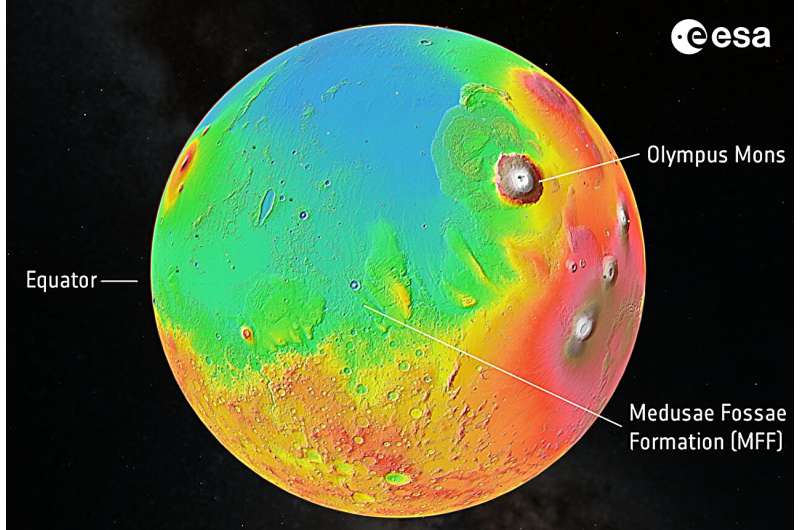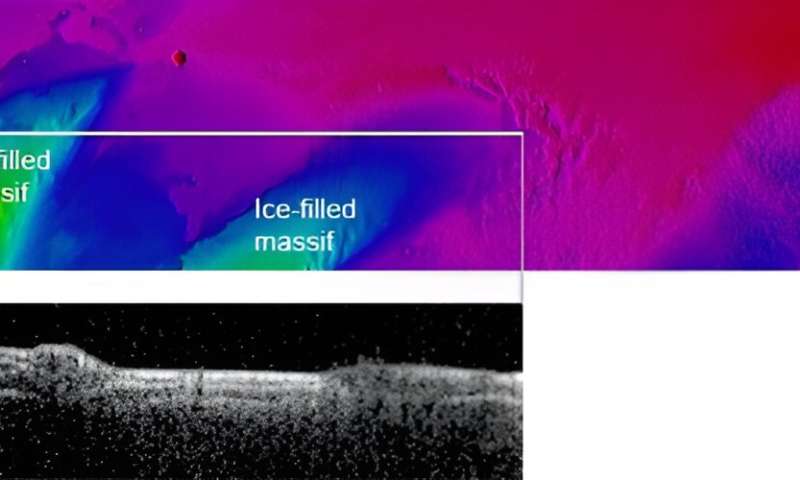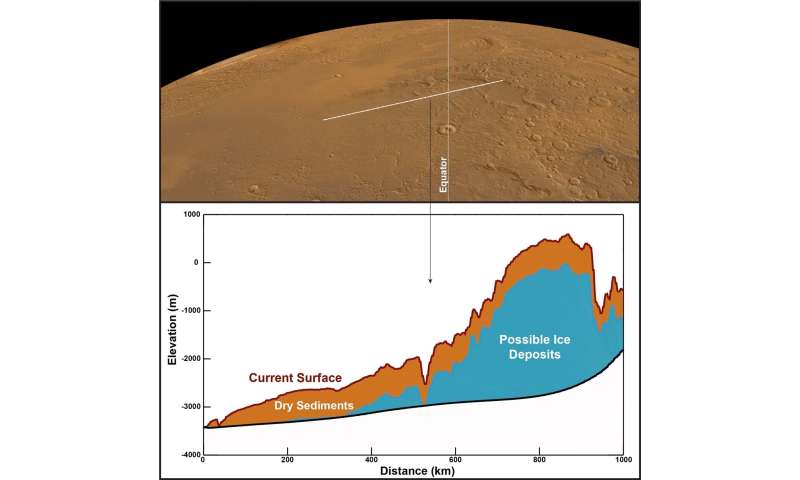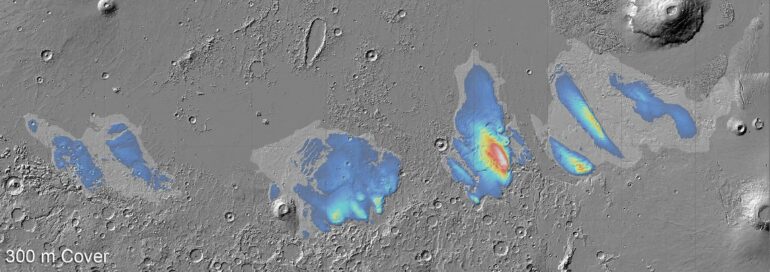Windswept piles of dust, or layers of ice? ESA’s Mars Express has revisited one of Mars’s most mysterious features to clarify its composition. Its findings suggest layers of water ice stretching several kilometers below ground—the most water ever found in this part of the planet.
Over 15 years ago, Mars Express studied the Medusae Fossae Formation (MFF), revealing massive deposits up to 2.5 km deep. From these early observations, it was unclear what the deposits were made of—but new research now has an answer.
“We’ve explored the MFF again using newer data from Mars Express’s MARSIS radar, and found the deposits to be even thicker than we thought: up to 3.7 km thick,” says Thomas Watters of the Smithsonian Institution, U.S., lead author of both the new research, published in Geophysical Research Letters, and the initial 2007 study. “Excitingly, the radar signals match what we’d expect to see from layered ice, and are similar to the signals we see from Mars’s polar caps, which we know to be very ice rich.”
If melted, the ice locked up in the MFF would cover the entire planet in a layer of water 1.5 to 2.7 m deep: The most water ever found in this part of Mars, and enough to fill Earth’s Red Sea.
Alternating layers of ice
The MFF consists of several wind-sculpted features measuring hundreds of kilometers across and several kilometers high. Found at the boundary between Mars’s highlands and lowlands, the features are possibly the biggest single source of dust on Mars, and one of the most extensive deposits on the planet.

Location of Mars’s Medusae Fossae Formation © ESA
Initial observations from Mars Express showed the MFF to be relatively transparent to radar and low in density, both characteristics we’d see from icy deposits. However, scientists couldn’t rule out a drier possibility: that the features are actually giant accumulations of windblown dust, volcanic ash or sediment.
“Here’s where the new radar data comes in. Given how deep it is, if the MFF was simply a giant pile of dust, we’d expect it to become compacted under its own weight,” says co-author Andrea Cicchetti of the National Institute for Astrophysics, Italy. “This would create something far denser than what we actually see with MARSIS. And when we modeled how different ice-free materials would behave, nothing reproduced the properties of the MFF—we need ice.”
The new results instead suggest layers of dust and ice, all topped by a protective layer of dry dust or ash several hundred meters thick.
Future exploration and collaboration
Although Mars now appears to be an arid world, the planet’s surface is full of signs that water was once abundant, including dried-up river channels, ancient ocean and lake beds, and water-carved valleys. We’ve also found significant stores of water ice on Mars, such as the enormous polar caps, buried glaciers nearer the equator, and near-surface ice laced through Martian soil.
Massive stores of ice near the equator—such as those suspected to lurk below the dry surface of the MFF—couldn’t have formed in the planet’s present climate. They must have formed in a previous climate epoch.
“This latest analysis challenges our understanding of the Medusae Fossae Formation, and raises as many questions as answers,” says Colin Wilson, ESA project scientist for Mars Express and the ESA ExoMars Trace Gas Orbiter (TGO). “How long ago did these ice deposits form, and what was Mars like at that time? If confirmed to be water ice, these massive deposits would change our understanding of Mars climate history. Any reservoir of ancient water would be a fascinating target for human or robotic exploration.”
The extent and location of these icy MFF deposits would also make them potentially very valuable for our future exploration of Mars. Missions to Mars will need to land near the planet’s equator, far from the ice-rich polar caps or high-latitude glaciers. And they’ll need water as a resource—so finding ice in this region is almost a necessity for human missions to the planet.

Close to Mars’s equator lies the Medusae Fossae Formation (MFF), a fascinating wind-sculpted region that may be the biggest single source of dust on Mars. When Mars Express turned its MARSIS radar sounder instrument towards the MFF, it revealed a surprise. The radar signals that echoed back match what we’d expect to see from layered deposits rich in water ice. In this image, the white horizontal line on the coloured height map of Mars’s surface (top) shows a narrow stretch of land that was scanned by MARSIS. The pop out below shows the radar data collected by the instrument that reveals the subsurface; the brighter the area, the stronger the radar echo received from that area. The white line covers two mounds separated by a valley. These mounds are clearly visible in the radar data below. Analysis of the radar data suggests that beneath a thick layer of dry material (likely dust or volcanic ash), the mounds are filled with water ice. © CReSIS/KU/Smithsonian Institution

Close to Mars’s equator lies the Medusae Fossae Formation (MFF), a fascinating series of wind-sculpted deposits that may be the biggest single source of dust on Mars. When Mars Express turned its MARSIS radar sounder instrument towards the MFF, it revealed a surprise. The radar signals that echoed back from below the surface match what we’d expect to see from layered deposits rich in water ice. In this image, the white line on Mars’s surface (top) shows a stretch of land that was scanned by MARSIS. The graph below shows the shape of the land and the structure of the subsurface, with the layer of dry sediments (likely dust or volcanic ash) in brown and the layer of suspected ice-rich deposits in blue. The graph shows that the ice deposit is thousands of metres high and hundreds of kilometres wide. If all the suspected water ice in the MFF melted, it would cover Mars in an ocean of water up to 2.7 m deep. © CReSIS/KU/Smithsonian Institution
“Unfortunately, these MFF deposits are covered by hundreds of meters of dust, making them inaccessible for at least the next few decades. However, every bit of ice we find helps us build a better picture of where Mars’s water has flowed before, and where it can be found today.”
While Mars Express maps water ice to a depth of a few kilometers, a view of near-surface water is provided by Mars orbiter TGO. This orbiter is carrying the FREND instrument, which is mapping hydrogen—an indicator of water ice—in the topmost meter of Martian soil. FREND spotted a hydrogen-rich area the size of the Netherlands within Mars’s Valles Marineris in 2021, and is currently mapping how shallow water deposits are distributed across the Red Planet.
“Together, our Mars explorers are revealing more and more about our planetary neighbor,” adds Colin.
More information:
Thomas Watters et al, Evidence of Ice-Rich Layered Deposits in the Medusae Fossae Formation of Mars, Geophysical Research Letters (2024).
Provided by
European Space Agency
Citation:
Mars Express finds evidence of large water deposit at the Medusae Fossae Formation (2024, January 19)



